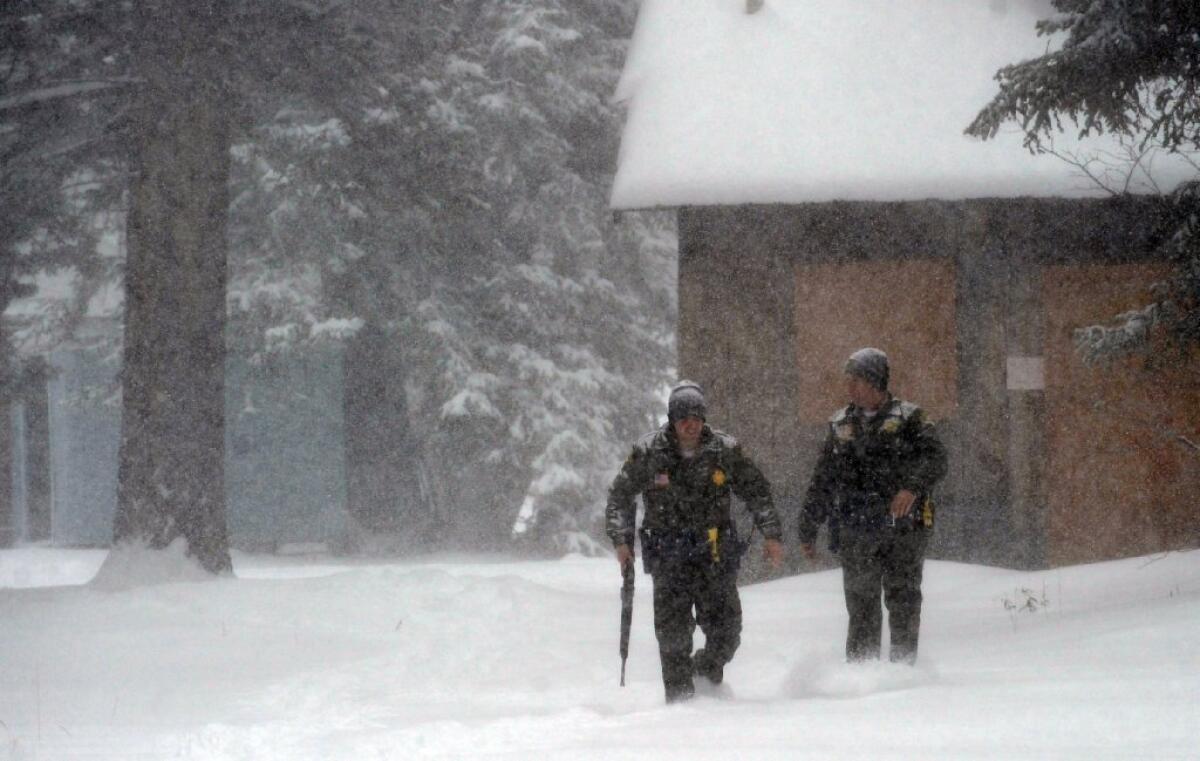Manhunt: How long could Dorner survive in the cold?

This week brought brutal weather conditions to Big Bear Lake, the location of a massive manhunt for murder suspect Christopher Dorner. Heavy snow fell. Temperatures hovered in the 20s. Winds were predicted to gust to 50 mph, creating a wind chill of 10 to 15 degrees and making it seem even colder.
As of Friday afternoon, sheriff’s deputies in San Bernardino County said they weren’t sure where Dorner was and that they thought he had left the area, though their searches there continued.
One reason to think he may have moved on from the town: If Dorner were still hiding in snowy woods near Big Bear, he would have needed to wear layered, insulated clothing — and crucially, to avoid getting wet — to survive for very long, said Dr. Brian Prestwich, an assistant professor of clinical family medicine at USC’s Keck School of Medicine. Cold weather poses a tremendous, and often unappreciated, threat to human survival.
PHOTOS: Manhunt for ex-LAPD officer
“The minute you’re exposed to the cold air or you get wet, the clock starts ticking,” Prestwich said.
It can take as little as 20 or 30 minutes for life-threatening hypothermia to strike an unprepared person when wind chills are as low as they were in Big Bear on Thursday, he noted.
When a person has hypothermia, his or her core body temperature falls dangerously low — to 95 degrees Fahrenheit or less, when measured with a rectal thermometer.
Once people in cold weather get wet, they lose body heat rapidly. If they’re unable to dry off and stabilize their body heat, things can spiral out of control quickly, Prestwich said.
“If you’re that guy in the forest, the thing you’ll notice first is uncontrollable shivering,” he said. “You may notice your speech is slurring. You might not be able to think clearly, and might have trouble concentrating. You’ll get less mobile, your hands will be awkward, you’ll stumble. Then you’ll start to feel drowsy, and you’ll just want to go to sleep. You go to sleep, and you die.”
Some patients with hypothermia also develop a sense of being too hot, he said. Sufferers have been known to strip off their clothes, hastening their demise.
The symptoms stem from a variety of breakdowns in the body. Mild hypothermia, which strikes at temperatures between 90 and 95 degrees, can cause high blood pressure, rapid heart rate and breathing, and loss of kidney function.
Patients with moderate hypothermia, at temperatures of 83 to 90 degrees, suffer heart arrhythmias and may lose consciousness.
Blood pressure drops precipitously in people who suffer severe hypothermia, with body temperatures below 83 degrees. They can become comatose and suffer kidney failure. Their lungs can fill with fluid.
Any combination of those things could be what kills a hypothermia sufferer, Prestwich said.
Also a danger for a person in Dorner’s situation would be frostbite, which can also set in within half an hour, Prestwich added. Exposed skin gets so cold that small blood vessels freeze, cutting off oxygen and leading to tissue death.
If Dorner was properly dressed for the wet and cold — wearing multiple layers and good insulated boots and socks, and keeping his head and neck warm with a heavy scarf and hat — he could last for days.
“I would suspect this guy knows everything we’re talking about and planned for it,” Prestwich said.
The National Weather Service publishes a wind chill chart that shows how quickly frostbite can strike. For more on surviving extreme cold, check out this thorough guide to cold weather survival.
More to Read
Start your day right
Sign up for Essential California for news, features and recommendations from the L.A. Times and beyond in your inbox six days a week.
You may occasionally receive promotional content from the Los Angeles Times.







